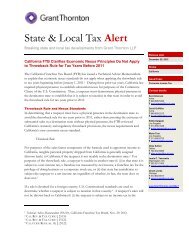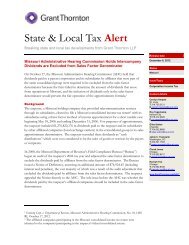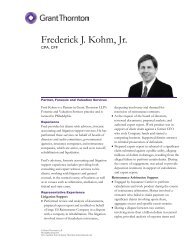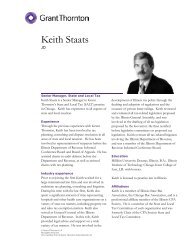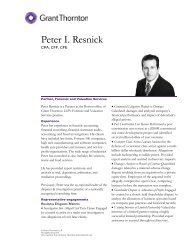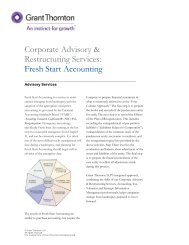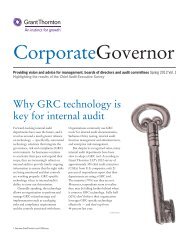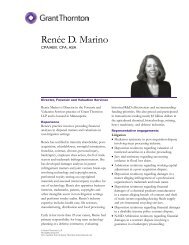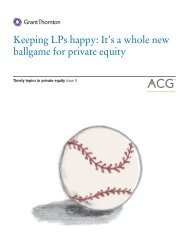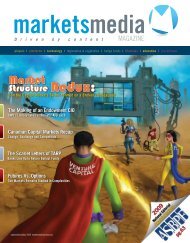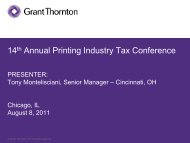Illinois issues new sales factor apportionment regulation for ...
Illinois issues new sales factor apportionment regulation for ...
Illinois issues new sales factor apportionment regulation for ...
You also want an ePaper? Increase the reach of your titles
YUMPU automatically turns print PDFs into web optimized ePapers that Google loves.
State & Local Tax Alert<br />
Breaking state and local tax developments from Grant Thornton LLP<br />
________________________________________________________<br />
<strong>Illinois</strong> Issues New Sales Factor Apportionment Regulation <strong>for</strong><br />
Publishing Industry<br />
On June 5, the <strong>Illinois</strong> Department of Revenue promulgated a <strong>new</strong> <strong>regulation</strong> addressing<br />
the computation of the <strong>sales</strong> <strong>factor</strong> used to determine a non!resident publisher’s taxable<br />
<strong>Illinois</strong>!sourced income. 1 The <strong>regulation</strong> discusses the sourcing of <strong>sales</strong> of (i) tangible<br />
published materials, (ii) nontangible published materials and (iii) publishing services, and<br />
provides definitions of relevant terms such as “published material” and “publishing<br />
services.” The <strong>regulation</strong> applies to taxable years ending on or after December 31, 2008,<br />
which is when <strong>Illinois</strong> adopted market!based sourcing <strong>for</strong> <strong>sales</strong> other than <strong>sales</strong> of<br />
tangible personal property. 2<br />
Definition of Publishing Terms<br />
“Publication” or “Published Material”<br />
The <strong>regulation</strong> defines the terms “publication” and “published material” as “the physical<br />
embodiment or printed version of any thought or expression.” 3 These terms include a<br />
play, story, article, column, or other literary, commercial, educational, artistic, or other<br />
written or printed work. Published material may take the <strong>for</strong>m of a book, <strong>new</strong>spaper,<br />
magazine or periodical and may be contained on any property or medium, including an<br />
electronic medium such as the Internet.<br />
“Publishing” or “Publishing Services”<br />
The <strong>regulation</strong> also defines the terms “publishing” and “publishing services” as “deriving<br />
business income from publishing, selling, licensing . . . or distributing <strong>new</strong>spapers,<br />
magazines, periodicals, trade journals or other published material.” 4 These terms do not<br />
include the delivery of materials published by a third party or the delivery of materials by<br />
the publisher <strong>for</strong> which a separate charge is made <strong>for</strong> the delivery.<br />
Sales of Tangible Published Materials<br />
An out!of!state publisher making <strong>sales</strong> of tangible published materials within <strong>Illinois</strong> is<br />
Release date<br />
June 20, 2012<br />
States<br />
<strong>Illinois</strong><br />
Issue/Topic<br />
Corporate Income Tax<br />
Contact details<br />
Paul Bogdanski<br />
Chicago<br />
T 312.602.8269<br />
E paul.bogdanski@us.gt.com<br />
Keith Staats<br />
Chicago<br />
T 312.602.8629<br />
E keith.staats@us.gt.com<br />
Vito Kirvelaitis<br />
Chicago<br />
T 312.602.8186<br />
E vito.kirvelaitis@us.gt.com<br />
Giles Sutton<br />
Dallas<br />
T 704.632.6885<br />
E giles.sutton@us.gt.com<br />
Jamie C. Yesnowitz<br />
Washington, DC<br />
T 202.521.1504<br />
E jamie.yesnowitz@us.gt.com<br />
Chuck Jones<br />
Chicago<br />
T 312.602.8517<br />
E chuck.jones@us.gt.com<br />
Hannah Yoo<br />
Chicago<br />
T 312.602.8338<br />
E hannah.yoo@us.gt.com<br />
www.GrantThornton.com/SALT<br />
1 ILL. ADMIN. CODE tit. 86 § 100.3373.<br />
2 See 35 ILL. COMP. STAT. 5/304(a)(3)(C!5).<br />
3 ILL. ADMIN. CODE tit. 86 § 100.3373(b)(2).<br />
4 ILL. ADMIN. CODE tit. 86 § 100.3373(b)(3).<br />
.
Grant Thornton LLP 2 2<br />
required to use the standard <strong>sales</strong> <strong>factor</strong> to compute its <strong>Illinois</strong> corporate income tax<br />
liability. 5 The numerator of the <strong>sales</strong> <strong>factor</strong> is the gross receipts attributable to <strong>Illinois</strong>,<br />
which are derived by the publisher from transactions and activities in the regular course of<br />
its trade or business. 6<br />
Applying the general <strong>sales</strong> <strong>factor</strong> <strong>regulation</strong>, gross receipts from the <strong>sales</strong> of tangible<br />
published materials are attributable to <strong>Illinois</strong> when the tangible published materials are<br />
“delivered or shipped to a purchaser within [<strong>Illinois</strong>] regardless of the f.o.b. point or other<br />
conditions of sale.” 7 The published materials are deemed to be delivered or shipped to a<br />
purchaser in <strong>Illinois</strong> if the “recipient” of the materials is located in <strong>Illinois</strong> (even if the<br />
purchaser ordered the materials from outside <strong>Illinois</strong>). 8 The published materials are also<br />
deemed to be shipped to a purchaser in <strong>Illinois</strong> if the shipment from the publisher to the<br />
purchaser terminates in <strong>Illinois</strong> despite the purchaser’s subsequent transfer of the materials<br />
to another state. 9 For example, if the materials are first shipped to a purchaser’s central<br />
warehouse in <strong>Illinois</strong> and the purchaser later reships the materials to its locations outside<br />
<strong>Illinois</strong>, the gross receipts from the materials are sourced to <strong>Illinois</strong>.<br />
The throwback rule contained in the general <strong>sales</strong> <strong>factor</strong> <strong>regulation</strong> also applies, pursuant<br />
to which gross receipts from the sale of tangible published materials destined <strong>for</strong> an out!<br />
of!state location or “the state of the purchaser,” but are not subject to tax, are “thrown<br />
back” into <strong>Illinois</strong> <strong>for</strong> taxation. 10<br />
In addition, the special rules relating to the standard <strong>sales</strong> <strong>factor</strong> also apply to the sale of<br />
published materials. 11 If the sale of published materials is not subject to tax in the state of<br />
origin outside <strong>Illinois</strong> or the state of destination, which is also outside <strong>Illinois</strong>, then the sale<br />
is sourced to <strong>Illinois</strong> if the publisher’s activities in <strong>Illinois</strong> are not protected by Public Law<br />
86!272. 12<br />
Sales of Nontangible Published Materials<br />
The gross receipts from <strong>sales</strong> of nontangible published materials containing advertising or<br />
customer lists are attributed to <strong>Illinois</strong> using the “circulation <strong>factor</strong>” <strong>for</strong> the “publication<br />
during the applicable tax period.” 13<br />
The “circulation <strong>factor</strong>” is the ratio that the publisher’s in!state circulation of nontangible<br />
published material (containing advertising) to <strong>Illinois</strong> purchasers and subscribers bears to<br />
the same nontangible published material being circulated everywhere. 14 The geographic<br />
location of the purchasers and subscribers is generally determined based on the publisher’s<br />
5 ILL. ADMIN. CODE tit. 86 § 100.3373(c)(1).<br />
6 ILL. ADMIN. CODE tit. 86 § 100.3370(c).<br />
7 ILL. ADMIN. CODE tit. 86 § 100.3370(c)(1)(A)(i).<br />
8 ILL. ADMIN. CODE tit. 86 § 100.3370(c)(1)(B).<br />
9 ILL. ADMIN. CODE tit. 86 § 100.3370(c)(1)(C).<br />
10 ILL. ADMIN. CODE tit. 86 § 100.3370(c)(1)(A)(ii).<br />
11 See ILL. ADMIN. CODE tit. 86 § 100.3380(c).<br />
12 Public Law 86!272, codified at 15 U.S.C. §§ 381!384, is a federal law that prohibits a state from imposing an<br />
income tax if the only in!state activity of the out!of!state person is the solicitation of orders <strong>for</strong> <strong>sales</strong> of<br />
tangible personal property where the orders are sent outside the state <strong>for</strong> approval or rejection and are filled by<br />
shipment or delivery from a point outside the state.<br />
13 ILL. ADMIN. CODE tit. 86 § 100.3373(c)(2).<br />
14 ILL. ADMIN. CODE tit. 86 § 100.3373(b)(1).
Grant Thornton LLP 2 3<br />
books and records. However, if the books and records are inadequate to determine where<br />
the purchasers and subscribers are situated, then the circulation <strong>factor</strong> can be determined<br />
by reference to rating statistics in sources such as Internet World Stats or Audit Bureau of<br />
Circulations. The publisher can also make an election to use such rating statistics. If the<br />
rating statistics are used, then the source selected must be consistent from year to year. 15<br />
The <strong>regulation</strong> provides an example of a company utilizing the circulation <strong>factor</strong>. 16 In the<br />
example, a company publishing advertising on the Internet <strong>for</strong> its customers elects to<br />
determine the circulation <strong>factor</strong> based on Internet World Stats. The company multiplies<br />
<strong>Illinois</strong>’ population by the Internet penetration percentage of the United States, as reported<br />
by Internet World Stats, and divides that amount by the combined populations of all<br />
jurisdictions in which the company does business multiplied by the Internet penetration<br />
percentages <strong>for</strong> each of the jurisdictions. The company must use this methodology in<br />
subsequent years.<br />
Sales of Publishing Services<br />
The <strong>regulation</strong> contains three cascading provisions that may apply to source <strong>sales</strong> of<br />
publishing services. It should be noted, however, that these three sourcing provisions only<br />
apply when the circulation <strong>factor</strong> is based on the publisher’s books and records. These<br />
provisions do not apply when the circulation <strong>factor</strong> is determined by a method other than<br />
the taxpayer’s own books and records, <strong>for</strong> example, if rating statistics are used.<br />
The first cascading provision requires that gross receipts from the per<strong>for</strong>mance of<br />
publishing services provided to a customer that is a corporation, partnership, or trust can<br />
only be attributed to a state in which the customer has a “fixed place of business.” 17 If the<br />
state where the publishing services are received cannot be readily determined or the<br />
customer does not have a “fixed place of business” in that state, then the second cascading<br />
provision applies, and services are deemed to be received at the ordering office or the<br />
location from which the customer placed the order <strong>for</strong> the services. 18 If the ordering<br />
office cannot be determined, then the third cascading provision applies, and services are<br />
deemed to be received at the customer’s billing address. 19 If the taxpayer is not taxable in<br />
the state in which the publishing services are received, the sale is excluded from both the<br />
numerator and the denominator of the <strong>sales</strong> <strong>factor</strong>, regardless of how the circulation <strong>factor</strong><br />
is determined. 20<br />
Commentary<br />
The Department’s long!awaited <strong>new</strong> <strong>regulation</strong> serves as useful guidance <strong>for</strong> multistate<br />
publishers making <strong>sales</strong> into <strong>Illinois</strong>. The <strong>regulation</strong> clarifies market!based sourcing <strong>for</strong><br />
<strong>sales</strong> of nontangible published material and publishing services. In particular, the<br />
<strong>regulation</strong> is useful to those publishers making <strong>sales</strong> of advertising which appears on<br />
Internet Web sites. The sourcing of such Internet advertising has not been addressed in<br />
15 Id.<br />
16 Id.<br />
17 ILL. ADMIN. CODE tit. 86 § 100.3373(d)(1).<br />
18 ILL. ADMIN. CODE tit. 86 § 100.3373(d)(2).<br />
19 ILL. ADMIN. CODE tit. 86 § 100.3373(d)(3).<br />
20 ILL. ADMIN. CODE tit. 86 § 100.3373(d)(4).
Grant Thornton LLP 2 4<br />
the past. The “circulation <strong>factor</strong>” is a <strong>new</strong> concept <strong>for</strong> <strong>Illinois</strong>, which conveniently allows<br />
<strong>for</strong> the possibility that a publisher may not have detailed in<strong>for</strong>mation relating to its<br />
customers’ locations or may not have the means to use such in<strong>for</strong>mation <strong>for</strong> purposes of<br />
the calculation of its <strong>Illinois</strong> income. The circulation <strong>factor</strong> concept also provides<br />
flexibility <strong>for</strong> the taxpayer to consider use of rating statistics instead of its own books and<br />
records, even if the books and records do keep detailed in<strong>for</strong>mation on where its<br />
customers receive the nontangible published material or publishing services.<br />
As the <strong>new</strong> <strong>regulation</strong> is being applied in a retroactive manner, all the way back to taxable<br />
years ending on or after December 31, 2008, some multistate publishers may be able to<br />
claim significant refunds <strong>for</strong> open tax years in the event that their initial sourcing<br />
methodology differed substantially from the promulgated <strong>regulation</strong>, resulting in an<br />
overstatement of the <strong>sales</strong> <strong>factor</strong>. Likewise, other multistate publishers may determine that<br />
the <strong>sales</strong> <strong>factor</strong> was understated <strong>for</strong> taxable years ending on or after December 31, 2008,<br />
resulting in an outstanding tax liability and consequent ASC 740 exposure. The<br />
Department will have to consider whether it is equitable to assert penalties on taxpayers<br />
finding themselves in this situation.<br />
The in<strong>for</strong>mation contained herein is general in nature and based on authorities that are subject to change.<br />
It is not intended and should not be construed as legal, accounting or tax advice or opinion provided by<br />
Grant Thornton LLP to the reader. This material may not be applicable to or suitable <strong>for</strong> specific<br />
circumstances or needs and may require consideration of nontax and other tax <strong>factor</strong>s. Contact Grant<br />
Thornton LLP or other tax professionals prior to taking any action based upon this in<strong>for</strong>mation. Grant<br />
Thornton LLP assumes no obligation to in<strong>for</strong>m the reader of any changes in tax laws or other <strong>factor</strong>s that<br />
could affect in<strong>for</strong>mation contained herein. No part of this document may be reproduced, retransmitted or<br />
otherwise redistributed in any <strong>for</strong>m or by any means, electronic or mechanical, including by photocopying,<br />
facsimile transmission, recording, re(keying or using any in<strong>for</strong>mation storage and retrieval system without<br />
written permission from Grant Thornton LLP.<br />
Tax professional standards statement<br />
This document supports the marketing of professional services by Grant Thornton LLP. It is<br />
not written tax advice directed at the particular facts and circumstances of any person. Persons<br />
interested in the subject of this document should contact Grant Thornton or their tax advisor<br />
to discuss the potential application of this subject matter to their particular facts and<br />
circumstances. Nothing herein shall be construed as imposing a limitation on any person from<br />
disclosing the tax treatment or tax structure of any matter addressed. To the extent this<br />
document may be considered written tax advice, in accordance with applicable professional<br />
<strong>regulation</strong>s, unless expressly stated otherwise, any written advice contained in, <strong>for</strong>warded with,<br />
or attached to this document is not intended or written by Grant Thornton LLP to be used,<br />
and cannot be used, by any person <strong>for</strong> the purpose of avoiding any penalties that may be<br />
imposed under the Internal Revenue Code.




